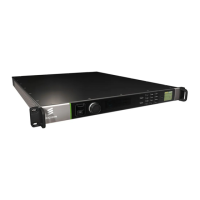• In SD and HD 1080i H.264 and HEVC operation the GOP structure should be
set to IBBBP.
• In HD 720p H.264 and HEVC use IBBBBBBP.
To achieve low encoding delay, the Low Delay Buffer mode should be used. In this
case, the recommended GOP structure is still IBBBP. To achieve even smaller
delays, a smaller number of B pictures can be used. The IBP GOP structure is the
best compromise between latency and picture quality and the IP GOP structure
gives the lowest possible delay, but may impact on video quality.
Table 3.23 GOP Length
Video Quality GOP Length
1080i 29.97 Hz 32
720p 59.94 Hz 60
1080i 25 Hz 24
720p 50 Hz 52
To achieve the lowest possible encoding delay Super Low Delay mode should be
used. In this mode, the GOP Structure options will change from the typical offerings
of: IBBBP etc… to: All P and I Frame only.
Profile
High@Level 4.0 is recommended for 4:2:0 mode and bit rates below 20 Mbps.
High@Level 4.1 will achieve the same performance, but allows higher bit rates up to
62.5 Mbps.
Hi422-10bit@Level 4.1 is recommended for better quality performance and allows
bit rates up to 80 Mbps.
Bit Rates
The maximum bit rate possible varies with the profile and level. However, if two or
more channels are in use, the maximum video bit rate for each channel is 30 Mbps.
CE-HEVC Card Teletext / Ancillary Data Rates
For single channel usage, the maximum data rate that can be supported is 500 kbps
for the combined Teletext and ancillary data, across all channels. This can be
subdivided in any way between the channels so long as the total bit rate does not
exceed 500 kbps.
HEVC HDTV 4:2:0 Recommendation
For HD HEVC Main Profile Level 4.0 High Tier 4:2:0 8 bit, the typical bit rate is
around 12 Mbps.

